


|
|
|
|
I figured as long as I was in Santiago and so close, 2,000 miles, I might as well go to Easter Island! I didn't realize that Patricia and Bill who are from Glasgow, were on the same flight from Santiago, they had been on the Tierra del Fuego cruise also.They had heard I was going to Easter Island and also that I was staying at the Hotel Okai and wanted to surprise me there. As fate would have it, their Lan Chile airline seats were right behind me, we all were surprised!
Flying into Easter Island from Santiago Chile - Lan Chile Airlines
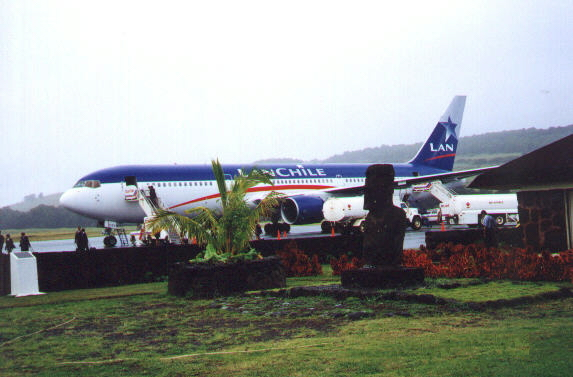
A
s we got off the plane we were received with
leis
and were picked up and driven to the hotel where we had a drink on the veranda at the
Okai Hotel
which is about two blocks from the beach and the great restaurants. So we started our vacation on a high note with expectations on seeing the famous statues on the island.
Our hotel is situated in Hanga Roa which is the only town on Easter Island. Most of the 2,000 Rapanui people that live on the island reside here. The only port on
the island is situated here, as is Cook's Bay, where Captain Cook anchored his boat just offshore in 1722.
Hotel - Cocktails and a Lei!
Private rooms at the hotel on Easter Island!
View of my patio at the Hotel Okai!
The New Friends I met on the cruise in Chile and Argentina!
Bill, Myself
and Patricia wearing our Leis!
Check out the Easter Island History and a
Map of Easter Island.
Lone Statue Overlooking the Town
The only statue containing coral eyes and the city beyond!
Easter Island is over 2,000 miles from the nearest population center, (Tahiti and Chile), making it one of the most isolated places on Earth. A triangle of volcanic rock
in the South Pacific - it is best known for the giant stone monoliths, known as Moai, that dot the coastline. The early settlers called the island "Te Pito O Te Henua" (Navel of The World). Admiral Roggeveen, who came upon the island on Easter Day in 1722, named it Easter Island. Today, the land, people and language are all referred to locally as Rapa
Nui.
If size signified importance, Ahu Vinapu was one of the most important ahu on Easter Island. The precisely fitted large basalt cut slabs
have perplexed some
archaeologists, in particular Thor Heyerdahl. He points to this
Inca-like stone ahu as a key indicator to a distinct Peruvian influence on the island. Few experts disagree that the stonework here is more advanced than that of other ahu on the island. Was this the result of an Inca influence on the island, or was it due to years of experience attained by Rapanui stoneworkers? An average slab here is eight by 5.5 feet (2.5 x 1.7meters) and weighs seven tons. Looking at the inhabitants of Easter Island, one can see their Polynesian features very clearly and they are not Peruvian.
Some have suggested that Easter Island is the remnant of a lost continent, or the result of an extra-terrestrial influence. Archaeological evidence, however, indicates discovery of the island by Polynesians at about 400 AD - led, according to legend, by Hotu Matua. Upon their arrival, an impressive and enigmatic culture began to develop. In addition to the statues, the islanders possessed the Rongorongo script; the only written language in Oceania. The island is also home to many
petroglyphs
(rock carvings), as well as traditional wood carvings, tapa (backcloth) crafts, tattooing, string figures, dance and music.
Old Stone Walls
Contacts with western "civilization" proved even more disastrous for the island population which, through slavery and disease, had decreased to approximately 111 by the turn of the century. Following the annexation by Chile in 1888, however, it has risen to more than 2,000, with other Rapanui living in Chile, Tahiti and North America. Despite a growing Chilean presence, the island's Polynesian identity is still quite strong .
Easter Island today, remains one of the most unique places you will ever encounter; an open air museum showcasing a fascinating, but unfortunately lost, culture. The Rapanui are among the friendliest people you will ever meet, and the landscape is truly amazing - with its volcanic craters, lava formations, beaches, brilliant blue water, and archaeological sites. We visited two of the craters on the island that contain fresh water and native plants, about the only place there are any left! One
crater
at Mirando Rano Kau was next to the petroglyphs of the Bird Man overlooking the small island where the men had to swim out to pick up an egg and put it into a pouch hanging from their necks and climb up the cliffs without breaking the egg! This was a test for the next chief of the tribe.
Mirando Crater
The natives brought with them on their ships, chicken, mice, sweet potatoes and other tubers. The sea doesn't seem very rich and then as now, they fish for tuna, sea bass, and two types of lobster. Our guide indicated that the priests and chiefs were only allowed to eat the chicken and tuna as it was 'gods' food. The rest of the population had to do all the work, eat tubers and what ever else was available, and build the statues while the upper class so to speak, had the privileges and the best food.
We were on tours almost all of the time, the first day we went on a tour in the morning to see the petroglyphs. It poured down rain and we had to laugh as the water ran off our noses. As we walked along the cliffs we saw a rainbow below us, the first time any of us had been above a rainbow! Then a tour in the afternoon, that's where we saw the
Moai statues
at Ahu Akivi, facing the Pacific toward their original home land thousands of miles to the southwest. Ahu Akivi is situated nine miles (15 kilometers) from the quarry. It has been estimated that the moai at this site were probably transported and erected after AD 1400. The NOVA moai has been modeled after one of the statues on this site, for here the moai are of an average shape, height, and weight of all the Easter Island moai. It is an unusual site because it is inland. Although many visitors assume the statues were placed here to face the ocean, in fact they were meant to look out over a very large village which today is in ruins. The site was restored in 1960 by the American archaeologist William Mulloy. During the restoration, it took a full month -- using a stone ramp and two wooden levers -- to raise the first of the seven moai. By the time they got to the last moai, the same task took them less than a week.
Stone Petroglyphs
Over Looking the Pacific Ocean
Chuck overlooking the Mirando Rano Kau Crater and the Pacific!
Statues Facing Soutwest
From the Rano Raraku volcano overlooking the Guarry Statues!
Statues on the
outside of an extinct volcano!
Raraku Crater
inside the extinct volcano!
The Only Sandy Beach with Palms
Ahu Tongariki Statues that were destroyed by the tidal wave from Chile!
Getting To Easter
Island
Lan Chile
flies to Easter Island, with flights operating between Santiago, Chile and Payette, Tahiti. Airfare from Santiago, Chile to Easter Island and back costs approximately $800 US. There are several companies who can arrange package trips, including hotels, tours etc., but it is possible, and much cheaper, to arrange a place to stay upon arrival. Many locals who operate hotels and guesthouses arrive at Mataveri Airport to greet the tourists, and is something you might consider. Staying in a private home is a great way to meet the islanders and experience the local culture; however, one should use judgment in choosing accommodations, as not all places are of equal quality.
Notably, the tourism on Easter Island is run entirely by the Rapanui themselves. In late January to early February the islanders celebrate Tapati, a festival honoring the Polynesian cultural heritage of the island. ( January 30
through February 14).
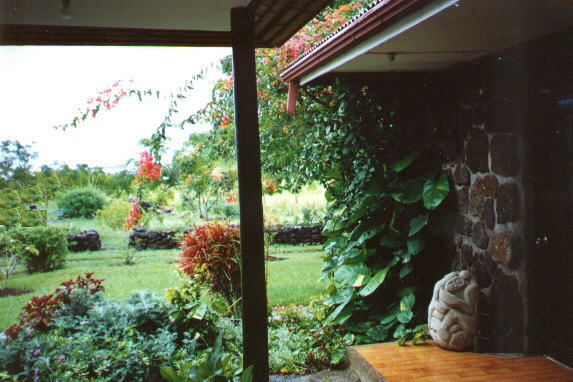
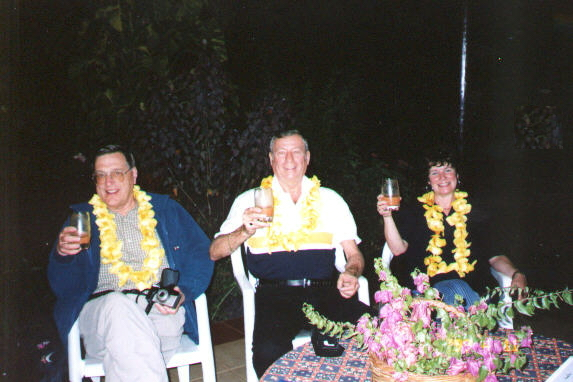
Situated near the town of Hanga Roa, the ahu at Tahai sits near a canoe ramp made of rounded beach stones, and was restored by the American archaeologist William Mulloy. Tahai is thought to be among the earliest ahu on the island, dating back to AD 690. This statue is the only one that has had the coral eyes put back into the sockets that were carved for them.

E
aster Island has long been the subject of curiosity and speculation. How and why did its inhabitants carve and transport the massive
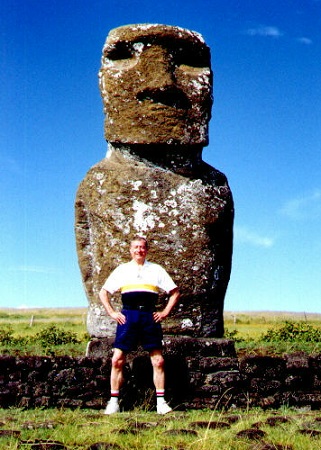 statues which surround the island? What remains of this culture today, and what lessons can we learn from their legacy? This island is also known as "Rapa Nui" and "Isla de
Pascua".
statues which surround the island? What remains of this culture today, and what lessons can we learn from their legacy? This island is also known as "Rapa Nui" and "Isla de
Pascua".
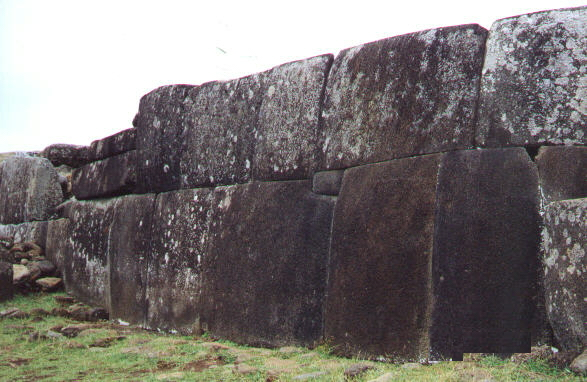
T
he population of Easter Island reached its peak at perhaps more than 10,000, far exceeding the capabilities of the small island's ecosystem. Resources became scarce,
and the once lush palm forests
were destroyed - cleared for agriculture and moving the massive stone Moai. In this regard, Easter Island has become, for many, a metaphor for ecological disaster. As you can see by this photo, I am sitting on a rock overlooking the Pacific and there is nothing there but grass, there isn't even a bush! Thereafter, a thriving and advanced social order began to decline into bloody civil war and, evidently, cannibalism. Eventually, all of the Moai standing along the coast were torn down by the islanders themselves. All of the statues now erected around the island are the result of recent archaeological efforts.
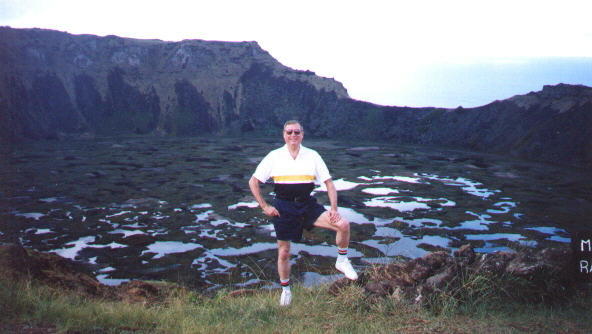
A
nother crater
was located at Rano Raraku, the main quarries where the natives went into some type of mental breakdown, the economy and life style was falling apart and the priests and leaders had the people carve more and more statues even though they were never moved. Many
statues are on the outside of the crater and many more were carved inside the crater. A lot of work was done that accomplished nothing in the long run. I led about six people on a climb to the top of the volcano and into the crater where there is a fresh water lake and a 3 meter tall reed that is natural to the island. This area was probably one of the most interesting, the shadows and ocean in the distance and being surrounded by statues had an air of mystery about it. But the following paragraph brings one back to reality where the common person is dictated to by the whims of others.
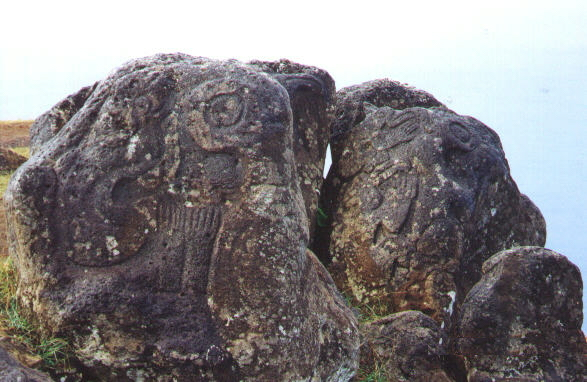
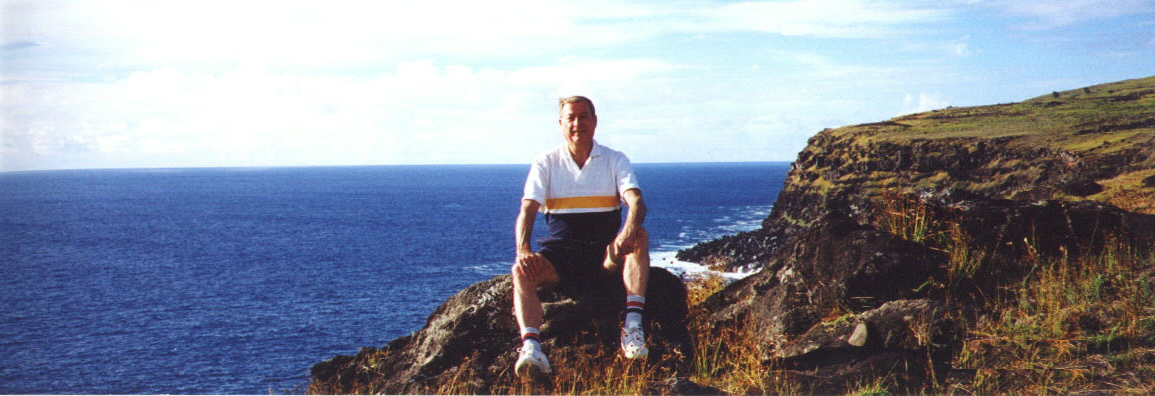
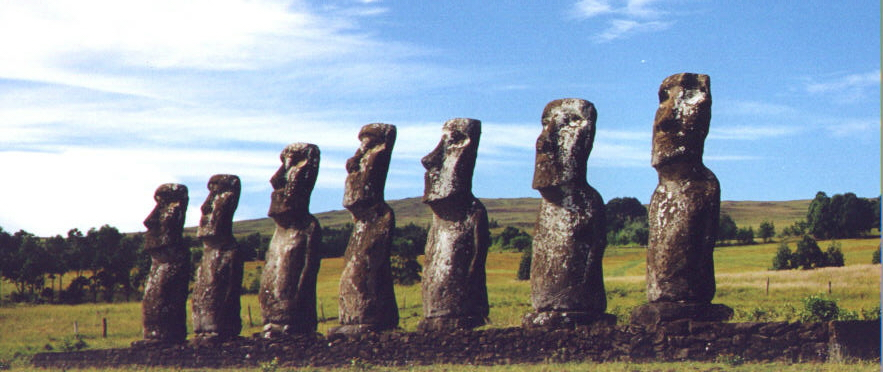
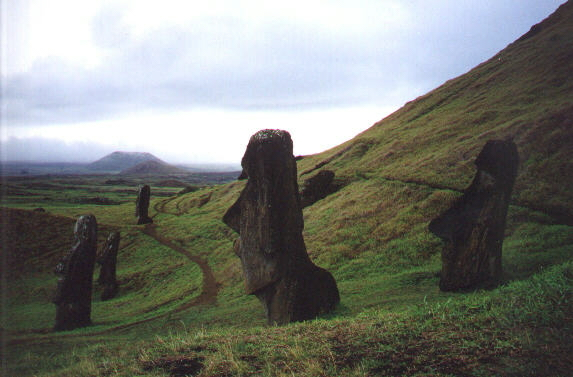
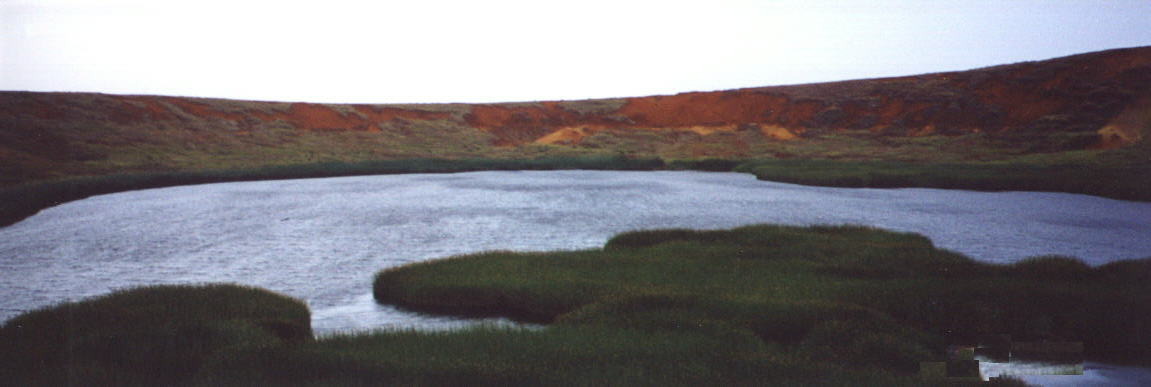
T
he second day we had an eight hour tour with two hours of swimming at the Anakena Beach,
only one of two sandy beaches on the island. It is believed to be the first place where the family of Hotu Matu'a landed after navigating the Pacific Ocean.
family of Hotu Matu'a landed after navigating the Pacific Ocean.
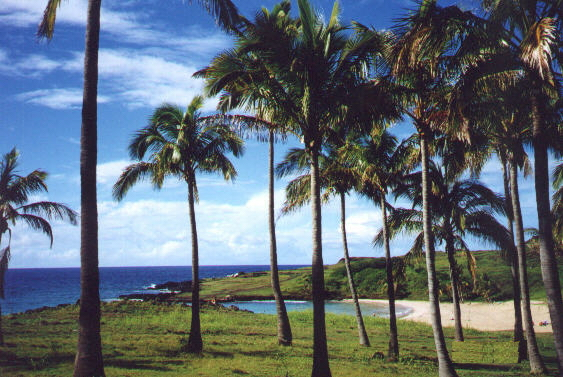
In the afternoon we went to Ahu Tongariki, where in 1960, an earthquake in Chile triggered a tidal wave, which hit the coast of Easter Island at Tongariki. The tidal wave sent the 15 Tongariki moai -- some of which weigh 30 tons -- several hundred feet inland. The ahu, the largest on Easter Island, was effectively destroyed. It wasn't until 1992 that the site was restored, under the direction of Chilean archaeologist, Claudio Cristino. The task took five years.
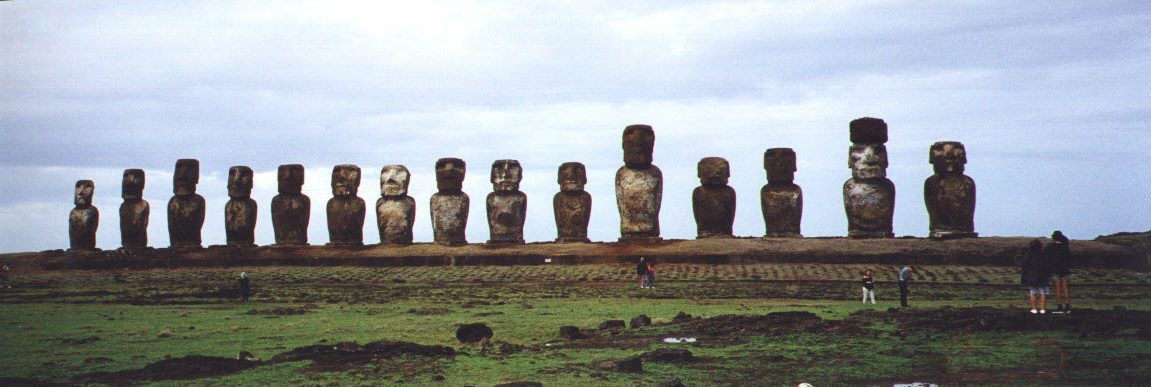
W
e met very nice people and had wonderful meals on decks by the ocean where the wine and gossip was rampant. We met a business man from Paris who had dinners with us and was most enjoyable. He indicated that he thought the United States was the best managed, capitalism at it's best! Bill, from England, indicated that the states might have been a power from 1955 to 1975 but now was so - so. I said that if California were a country it would be around the sixth riches in the world. The Frenchman just laughed, he said the British still live in the past, if the
US isn't the only world power, who is he asked. No response from the British! We had one day to relax and then back to the City, another long haul from Easter Island to Santiago, Santiago to Lima, Lima to Los Angeles, and finally to San Francisco!
San Francisco California

Created on:
1999.04.10
Updated on:
2015.11.07